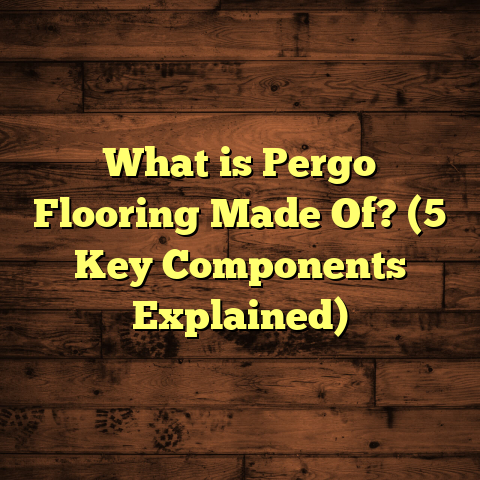What is Pickled Oak Flooring? (5 Benefits for Stunning Interiors)
When I first started searching for flooring that could handle the chaos of pets, I wasn’t just looking for something pretty. I wanted a floor that would last through muddy paws, accidental spills, and the occasional scratch from sharp claws. Maybe you’ve been there too—the struggle to find the perfect balance between style and function for a home with pets. That’s when pickled oak flooring caught my eye.
I want to share everything I’ve learned about pickled oak flooring—from what it is and how it’s made to why it’s one of the smartest choices for pet owners who want stunning interiors. We’ll also get into the nitty-gritty of maintenance, installation, costs, and some real-life stories to give you the full picture.
What is Pickled Oak Flooring?
Pickled oak flooring is a special finish applied to oak hardwood that bleaches or “pickles” the wood’s natural color. The process highlights the wood grain while washing out darker tones to create a pale, almost whitewashed look. This technique keeps the textures and knots visible but gives the floor an airy, fresh feel that can brighten up any room.
How Pickling Works
You might wonder how pickling differs from other wood treatments. Well, pickling involves applying a white or light-colored stain (often water-based) on the oak surface. This stain soaks into the wood fibers but is then wiped away before fully drying, leaving behind a translucent tint that softens the wood’s natural color without hiding its grain.
Unlike bleaching—which chemically strips color—pickling adds a subtle whitewash effect that preserves character. And different pickling recipes can produce varying shades from soft grays to creamy whites.
Why Oak?
Oak is a classic hardwood with a rich texture and strong grain pattern. It’s popular for flooring because of its:
- High durability (Janka hardness rating between 1290–1360)
- Attractive grain with natural knots and rays
- Resistance to wear and dents compared to softer woods
- Ability to be stained and finished in many styles
Pickled oak combines oak’s toughness with an updated look that suits contemporary interiors while still nodding to rustic charm.
Types of Oak Used
There are two main species used in pickled oak flooring:
- Red Oak: Slightly softer and has a warm reddish hue that pickling tones down.
- White Oak: Denser and more moisture resistant with a cooler, neutral color that complements pickling beautifully.
I personally prefer white oak for pet areas because it handles moisture better—great if you have accidents or wet paws.
Why Pickled Oak Flooring Works for Pet-Friendly Homes
After experimenting with various floors in my own home (including laminate, tile, and carpet), I found pickled oak met all my needs. Here are five reasons why it’s become my go-to recommendation for pet owners:
1. Durability That Stands Up to Pets
Pets can be tough on floors. Sharp claws can scratch surfaces; dogs and cats sometimes have accidents; even their nails clicking on floors can cause wear over time.
Oak’s natural hardness means it resists dents and scratches better than softer woods like pine or fir. The pickled finish helps camouflage minor damage because lighter floors don’t show scratches as readily as dark stains do.
In my experience, after a year of having two dogs running around, my pickled oak hallway still looks great with only faint lines blending into the finish — a huge win compared to the deep gouges I used to see on darker floors.
2. Easier Cleaning and Maintenance
One thing every pet owner knows is that floors need constant cleaning. Whether it’s shedding hair, tracked-in dirt, or spilled water bowls, messes happen daily.
Pickled oak floors don’t trap hair like carpets do and are less slippery than glossy floors, making it safer for pets and easier for me to sweep or vacuum regularly. A damp mop with gentle hardwood cleaner keeps things fresh without damaging the finish.
What surprised me was how well a quality polyurethane sealant protects against stains and moisture on pickled oak. When my dog accidentally knocked over his water bowl, I wiped it up right away—no staining or swelling occurred.
3. Brightens Your Space While Hiding Wear
Because pickled oak has a light tone, it reflects natural light beautifully, creating a bright and inviting atmosphere in rooms where pets spend most of their time. This was a game-changer for me since my living room faces north and tends to be dark.
Additionally, lighter floors tend to hide dust, pet hair, and light scratches better than darker floors—something I noticed while doing weekly cleanings. This means your floors look cleaner longer between deep cleans—a real time saver!
4. Flexible Style That Grows With Your Home
A lot of pet-friendly flooring choices lean toward either rustic or ultra-modern looks. Pickled oak is versatile enough to fit both—and everything in between.
Because it has natural grain texture but a soft color palette, you can change your home’s decor without worrying about the floor clashing with new furniture or paint colors. I’ve refreshed my living room look three times over five years without ever feeling like the floor was outdated.
This adaptability also means pickled oak works well in different rooms—living rooms, bedrooms, kitchens—and complements other flooring types if you decide on mixed materials.
5. An Environmentally Responsible Option
Sustainability matters to me—especially when choosing materials that impact indoor air quality and long-term waste.
Many brands offering pickled oak flooring source their wood from sustainably managed forests certified by organizations like FSC (Forest Stewardship Council). Plus, the water-based stains used in pickling are low in volatile organic compounds (VOCs), which means fewer harmful fumes inside your home—a big relief when you have pets breathing close to the floor.
Hardwood floors also last longer than vinyl or laminate alternatives, reducing replacement cycles and waste over time.
How Pickled Oak Compares With Other Pet-Friendly Flooring Options
You’re probably wondering how pickled oak stacks up against other popular pet-friendly floors like laminate, vinyl plank, tile, or carpet alternatives.
Let me break down the pros and cons based on what I’ve seen working in real homes:
| Flooring Type | Durability | Pet Comfort | Maintenance Ease | Style Variety | Cost Range (per sq ft) |
|---|---|---|---|---|---|
| Pickled Oak | High | Moderate | Moderate | High | $6 – $12 |
| Laminate | Moderate | Moderate | Easy | High | $2 – $5 |
| Vinyl Plank | High | High | Very Easy | High | $3 – $7 |
| Tile (Porcelain) | Very High | Low | Easy | Moderate | $5 – $15 |
| Carpet | Low | High | Hard | Moderate | $2 – $6 |
- Laminate is budget-friendly but can’t be refinished if scratched.
- Vinyl plank is waterproof and soft underfoot but lacks hardwood’s authentic look.
- Tile is durable but cold and slippery.
- Carpet is comfortable but traps hair and stains easily.
Pickled oak strikes a balance: It offers genuine hardwood beauty with durability suitable for pets—plus you get the option to refinish it if needed.
Deep Dive: Installation Process & Challenges
I always advise homeowners considering pickled oak flooring to understand what installation involves so there are no surprises.
Materials Needed
- Pre-finished or unfinished pickled oak planks
- Underlayment (for moisture barrier and soundproofing)
- Adhesive or nails (depending on installation method)
- Tools: saws, spacers, tapping block, hammer/mallet
Installation Methods
There are several ways to install pickled oak:
- Nail-down: Traditional method for solid hardwood on wooden subfloors.
- Glue-down: Common for engineered hardwood over concrete slabs.
- Floating: Planks click together over an underlayment; good for DIY projects.
I went with glue-down on my basement hallway because the concrete slab required moisture protection.
Challenges
- Subfloor prep: Must be level and clean; unevenness causes problems.
- Acclimation: Wood needs time (often 48–72 hours) in your home environment before installation.
- Expansion gaps: Necessary around room edges to allow wood movement with humidity changes.
- Finish protection: Avoid heavy traffic immediately after installation until finish cures fully.
Hiring experienced installers can make a huge difference here if you’re not comfortable doing it yourself.
Real-Life Case Study: My Client’s Pickled Oak Journey
One of my clients recently installed pickled oak flooring throughout their open-plan living area where they have two active dogs and a cat. They wanted something bright yet durable that wouldn’t show pet hair or scratches easily.
We selected white oak planks with a matte pickled finish sealed with aluminum oxide polyurethane for extra protection. After 18 months:
- The floors retained their light tone without yellowing.
- Minor scratches from dog nails were barely visible.
- Cleaning routine was simple—vacuum twice weekly plus mop monthly.
- The family appreciated how much brighter their home felt.
- The client reported zero pet-related damage affecting the finish negatively.
They told me it felt like they finally found a floor that worked with them instead of against them—a huge relief when balancing aesthetics with pet life.
How to Maintain Pickled Oak Flooring With Pets
Keeping your floors looking great requires some care but nothing too complicated:
Regular Cleaning Schedule
- Sweep or vacuum daily to remove dirt and pet hair.
- Use microfiber mops dampened with pH-neutral wood cleaners weekly.
- Wipe up spills immediately to avoid stains or water damage.
Nail Care for Pets
Trim your dog’s nails regularly or consider nail caps if scratching becomes excessive. This simple step can prevent most surface damage.
Protect High-Traffic Areas
Place rugs or runners in spots where pets eat or rest often. Choose rugs with non-slip backing to keep everyone safe.
Avoid Harsh Chemicals
Stay away from ammonia-based cleaners or abrasive scrubbing tools that break down finishes faster.
Cost Breakdown: Is Pickled Oak Worth It?
Budgeting for flooring can be overwhelming. Here’s an honest look at costs based on recent market data:
| Expense Item | Price Range | Notes |
|---|---|---|
| Pickled Oak Material | $6 – $12 / sq ft | Depends on quality & source |
| Installation Labor | $3 – $6 / sq ft | Varies by region & complexity |
| Underlayment | $0.50 – $1 / sq ft | Moisture & sound barrier |
| Finishing (if unfinished) | $2 – $5 / sq ft | Stain + polyurethane coats |
| Additional Supplies | $100 – $300 | Nails, adhesives, tools |
Total cost often falls between $9 – $20 per square foot installed—higher than laminate but less than some exotic hardwoods or tile options.
In my opinion, given its longevity and style benefits, pickled oak offers excellent value over time especially in pet homes where durability matters most.
Frequently Asked Questions About Pickled Oak Flooring & Pets
Q: Will pickled oak hide pet stains?
A: The light finish helps mask minor discolorations compared to darker floors but sealing quality is critical to preventing stains from setting in hardwood pores.
Q: Can I use radiant heating under pickled oak?
A: Yes! Engineered pickled oak performs well with radiant heat systems as long as installation guidelines are followed carefully.
Q: How does humidity affect pickled oak?
A: Like all hardwoods, pickled oak expands and contracts with moisture changes. Proper acclimation and expansion gaps reduce risks of warping or gaps forming.
Q: Does sunlight fade pickled oak?
A: Prolonged exposure can cause slight yellowing or fading over years. Using window treatments helps protect your floors’ color integrity.
Final Thoughts From My Flooring Journey With Pets
Choosing the right floor for pets isn’t just about picking something tough—it’s about finding a surface that fits your lifestyle aesthetically and functionally.
Pickled oak flooring offers an outstanding mix of durability, beauty, ease of maintenance, and environmental friendliness that makes it stand out among other hardwood options I’ve worked with over the years.
If you’re looking for floors that brighten your home while standing up to whatever your pets throw at them—without losing their charm—I think you’ll love what pickled oak brings to the table.
Feel free to reach out if you want advice tailored specifically to your home setup or need help finding reputable installers near you. I’m always happy to chat about floors!
If you want me to expand specific sections further or add more technical details like finishing techniques, species comparisons, or product recommendations, just let me know!





